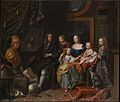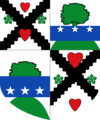George Watson-Taylor facts for kids
Quick facts for kids
George Watson-Taylor
M.P.
|
|
|---|---|
| Born | 1771 |
| Died | 1841 |
| Occupation | writer, plantation owner, politician, collector |
George Watson-Taylor (born 1771 – died 6 June 1841) was a wealthy plantation owner from Jamaica. He also served as a Member of Parliament (MP) in the United Kingdom. In 1810, he married into the rich Taylor family, later adding "Taylor" to his own name. This made him one of the wealthiest plantation owners in Jamaica.
He bought a grand house in London and a large estate called Erlestoke Park in Wiltshire. As an MP, he supported the government and argued against ending slavery. Watson-Taylor was also famous for his amazing collection of art. However, he later faced serious money problems and died in Edinburgh in 1841.
Contents
Early Life and Education
George Watson-Taylor was the fourth son of George Watson, who owned land in Saul's River, Jamaica. He began his education in law at Lincoln's Inn in 1788. Later, in 1791, he studied at St. Mary Hall, Oxford University.
Political Career and Views
In 1815, George Watson officially changed his last name to Watson-Taylor. He became a Member of Parliament (MP), which is like being a representative in the government. He served for several areas:
- Newport, Isle of Wight (1816–1818)
- Seaford (1818–1820)
- East Looe (1820–1826)
- Devizes (1826–1832)
When he first became an MP, he joined a group called the Society of West India Planters and Merchants. This group represented the interests of plantation owners. George Watson-Taylor was against ending slavery. When slavery was abolished in the 1830s, he received a large amount of money, over £20,000, as compensation for the more than 1,000 enslaved people on his plantations in Jamaica.
Later Life and Financial Struggles
George Watson-Taylor inherited a lot of money from his wife's family. However, he spent money very freely and did not manage his finances well. By 1832, he was deeply in debt. He was forced to sell many of his personal belongings at auctions.
He eventually went bankrupt and moved to Amsterdam. Later, he found a safe place for people in debt at Holyrood Palace in Scotland. He died in Edinburgh in 1841, still facing financial difficulties. His estates in Erlestoke and Jamaica then passed to his wife, who died in 1853.
Art Collecting and Grand Homes
George Watson-Taylor was known as a "great collector and expert" in fine art. In 1811, he bought paintings from Henry Hope's collection. He was also famous for his collections of sculptures and fancy French furniture.
In 1816, while living in London, he bought more paintings from Hope's collection. One famous painting he bought was Everhard Jabach and His Family by Charles LeBrun, which is now in the Metropolitan Museum of Art. In 1820, he moved into Hope's old house on Harley Street, which was also considered part of Cavendish Square. This large house was built in the 1720s.
From 1821 to 1824, the Watson-Taylors hosted many grand parties at their London home. But as their money problems grew, the house was closed in 1825. In 1823, Watson-Taylor held a major sale of 131 old master paintings from this house. One painting sold was The Courtyard of the Old Exchange in Amsterdam by Emanuel de Witte.
King George IV was very interested in Watson-Taylor's furniture collection. Part of this collection was sold in 1825. The King bought many important pieces for Windsor Castle. By this time, the Watson-Taylors were living in Grafton Street, Mayfair, when they were in London.
In 1826, George Watson-Taylor became a Fellow of the Royal Society, a group for important scientists. In 1830, he had a book of his own short poems and two plays privately printed.
By 1832, his financial problems worsened, and he had to sell everything inside Erlestoke House. His large library of books was sold in two parts, bringing in over £8,700. His collection of valuable small objects, called objets de vertu, was also sold that year.
Family Life
In 1810, George Watson married Anna Susanna. She was the daughter of Sir John Taylor, a wealthy man from Jamaica. George received a lot of money from the sugar cane plantations of Anna's uncle, Simon Taylor, who died in 1813.
In 1815, George was officially allowed to add "Taylor" to his name. This happened after his wife's cousin, Sir Simon Richard Brissett Taylor, died, and his wife became the main heir. He was also granted a special family crest.
The inheritance made George and Anna very rich. They bought a large estate in Wiltshire for £200,000 and spent £68,000 renovating a house in London. They socialized with King William IV and even hosted the future Queen Victoria.
George and Anna had four sons and one daughter:
- Simon Watson Taylor (born 1811) briefly served as an MP for Devizes.
- John Walter Watson-Taylor (born 1813, died 1832). A famous sculptor named John Gibson made a bust (a sculpture of his head and shoulders) of him in 1816. Gibson also made busts of John's younger brother George and sister Isabella that same year.
- George Graeme Watson-Taylor, the third son, married Victorine Joudioux in 1847 and died in 1865.
- Emelius Watson-Taylor, the youngest son, died in 1879. Another sculptor, Edward Hodges Baily, made a bust of him in 1825.
Their daughter, Isabella, never married. She died in 1892 at Erlestoke Park, Wiltshire, leaving behind £69,000. She owned Headington Manor House in Oxfordshire, which her brother Emilius had bought in 1867.
Images for kids






